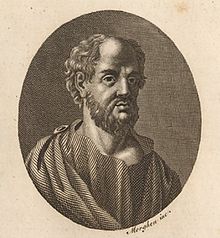Zeuxis | |
|---|---|
 | |
| Born | c. 464 BCE |
| Died | c. 4th century BCE[1] Place of death unknown |
| Cause of death | Death from laughter |
| Occupation | Painter |
Zeuxis (/ˈzjuːksɪs/; ‹See Tfd›Greek: Ζεῦξις)[2] (of Heraclea) was a late 5th-century- early 4th-century BCE Greek artist famed for his ability to create images that appeared highly realistic.[3][4] None of his works survive, but anecdotes about Zeuxis' art and life have been referenced often in the history and literature of art and in art theory.[5]
Much of the information about Zeuxis comes from Pliny the Elder's Natural History, but his work is also discussed by Xenophon[6] and Aristotle.[7] One of the most famous stories about Zeuxis centers on an artistic competition with the artist Parrhasius to prove which artist could create a greater illusion of nature.[8] Zeuxis, Timanthes and Parrhasius were painters who belonged to the Ionian School of painting. The Ionian School flourished during the 4th-century BCE.[9][10][11]
- ^ Chilvers, Ian (2003). "Zeuxis". The Concise Oxford Dictionary of Art and Artists. Retrieved 7 November 2010.
- ^ William Smith (1880). A Dictionary of Greek and Roman Biography and Mythology: Oarses-Zygia. J. Murray. p. 1325.
- ^ Matheson, Susan B. (2003). "Zeuxis". Grove Art Online. Retrieved February 20, 2024.
- ^ "Zeuxis: The Ancient Greek Painter & Master of Still Life". TheCollector. 2020-06-09. Retrieved 2021-08-12.
- ^ Mansfield, Elizabeth. Too Beautiful to Picture: Zeuxis, Myth, And Mimesis. U of Minnesota Press. ISBN 978-1-4529-0916-5.
- ^ Xenophon Oec. 10
- ^ Aristotle, Poetics 6.5
- ^ Elsner, Jas (1996-06-27). Art and Text in Roman Culture. CUP Archive. pp. 184–186. ISBN 978-0-521-43030-2.
- ^ Clement, Clara Erskine (2024). A History of Art for Beginners and Students: Painting, Sculpture, Architecture Painting: An Artistic Journey Through Time. New Delhi, India: Namasakr Books. p. 14. ISBN 9782023122518.
- ^ Dyer, Thomas Henry (1882). On Imitative Art, with Preliminary Remarks on Beauty, Sublimity and Taste. London, England: George Bell and Sons. p. 280-281.
- ^ Gilman, Daniel Coit; Peck, Harry Thurston; Colby, Frank Moore, eds. (1906). "Ionian". The New International Encyclopaedia. Vol. 10. New York, NY: Dood, Mead and Company. p. 734. Retrieved September 10, 2023.